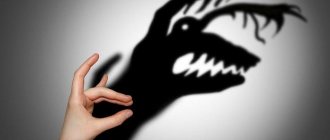About the nature of fear
Fear needs no special introduction. Everyone is familiar with the state when the heart begins to beat wildly from fear, the body becomes covered with sticky sweat, and the hands and voice tremble treacherously. Nobody likes to be afraid, because fear is a negatively colored emotional process. But it is important to understand that fear has a positive biological function and contributes to the survival of the body.
The emotion of fear arises in situations that are perceived as threatening and triggers physiological processes in the body that help implement avoidance behavior. Immediately after determining the situation as extreme, the hypothalamus produces the regulatory hormone corticorelin. Having reached the adrenal glands, it stimulates the production of specific fear hormones - adrenaline and norepinephrine.
The release of adrenaline leads to the fact that blood flows in excess to the heart and skeletal muscles, the intestinal muscles relax, and the pupils dilate. The body instantly becomes ready to run and seek shelter. When the pupils are dilated, more light enters the retina of the eye, and the ability to receive information about a dangerous object and look for escape routes increases. The reflex flow of blood to the muscles increases their performance.
Norepinephrine, which is called the “rage hormone,” is also involved in the fight-or-flight behavior. It increases vigilance and promotes faster decision-making in extreme situations.
Without adrenaline and norepinephrine, the body is defenseless in the face of danger. Laboratory experiments prove this: animals whose adrenal medulla, the source of catecholamine hormones, were removed showed an inability to take actions aimed at survival (to run away from impending danger, to defend themselves, to get food).
What is anxiety?
One of the forms of fear is anxiety. Unlike fear, anxiety arises not only when directly confronted with a threat, but as a result of anticipation of this event in the future. That is, in reality, a dangerous situation may never occur, but a person experiences the whole range of experiences characteristic of fear.
Anxiety, like fear, has a positive function and is a subconscious mobilization of the body’s mental forces to prevent difficulties from arising in a situation the outcome of which is not easy to predict. However, the problem is that people cannot withstand mental stress and try to get rid of anxiety and fear, instead of reacting to them correctly and using them to improve their effectiveness.
In attempts to overcome anxiety, a person does not take into account the importance of working with the meaning of a negative experience. It is necessary to understand that the presence of fear signals that some vital values are affected.
Manifestations of fear of life
A person suffering from the fear of living lives a very event-poor life. Its existence is determined and predictable, since any kind of novelty is rejected. The need to take unconventional actions, creative decisions, and let new people into your life raises a level of fear and anxiety that a person cannot cope with. As a result, life turns into an endless “Groundhog Day”.
The worst thing for a person suffering from fear of life is the inability to control fateful events when something happens that is impossible to influence. By avoiding new experiences, a person seems to take control of the course of life. Nothing unexpected or exciting happens in his life. But at the same time, a person is insured against major losses and failures. The logic of action is this: it is better for nothing to happen than for something terrible to happen. If you don’t leave the house again, you won’t be hit by a car. If he doesn’t get married, then divorce can be avoided, and so on. Risks are minimized.
Persons experiencing fear of life tend to exaggerate in their assessments the scale of the negative consequences of events. For example, you were fined for speeding. Just think - it's no big deal. However, this episode is regarded by humans as something terrible and catastrophic. The whole point is that he intensifies the feeling of fear that is still in the background and poorly understood: “I have no power over this world,” “things that I did not choose can happen to me.”
The purpose of negative emotions
Emotions appear in response to various kinds of changes not only in the external, but also in the internal environment of the body. There are close functional relationships between the first (sensations) and second (rational thinking) signaling systems. Emotional reactions are part of the first signaling system, much older than our conscious thinking. Without it, we will not be able to navigate reality. Any emotions, including fear and anxiety, are included to direct our thought process in the right direction.
For example, focusing on the shortcomings of a loved one leads to quarrels and disunity. Focusing on his strengths strengthens the bond. When choosing the first strategy of behavior, we feel negative emotions - disappointment, irritation, anger. Following the second strategy, we experience positive feelings - gratitude, love.
Our unconscious tells us, with the help of emotions, the shortest path to what we want. Negative emotions are akin to the physical pain that occurs when we touch a hot frying pan with our bare hands. The pain forces you to withdraw your hand and save the soft tissues from the burn. Anger, shame, fear, and anxiety should ideally also force a person to change his behavior to a more constructive one. And we are primarily talking about thought processes, and not about any specific actions.
For example, a person is afraid of going on a date. But negative emotions are not caused by the date itself and the opportunity to present yourself in a bad light. The emergence of anxiety provokes the conclusion that such an outcome will confirm a person’s deeply rooted belief in his own inadequacy and inability to receive love. Fear in this case should help you discover and get rid of destructive beliefs, and not avoid the date itself.
How to work with fear?
To stop being afraid of fear, a person needs to learn to trust his feelings. To do this, it is necessary to develop some observation and self-reflection skills in order to realize that any emotions, including anxiety and fear, arise according to the scheme: situation - mental assessment - emotional reaction.
Tracking Negative Thoughts
An emotional response to a situation reflects the “label” that is “pasted” on it. For example, that she is dangerous or unpleasant. Let's say you started your business but failed. Thoughts like “I’m just a loser,” “I aimed too high,” “I don’t have the ability” cause a powerful flow of strong negative feelings: disappointment, shame, guilt. It is the voice of the unconscious mind that warns you that you are holding thoughts that are harmful to you. After all, such thoughts make you give up and give up new attempts to achieve success.
Imagine if a baby learning to walk thought like this: “Well. I fell. Apparently, upright walking is not my thing.” The child is not yet familiar with the idea of failure. He simply follows the joy that new experiences bring him.
Or, for example, you were in an accident. The first judgment that comes to mind, “Oh, God, I almost died - what a horror!”, triggers a whole series of thoughts about one’s own vulnerability. The result of such thinking will, of course, be fear and anxiety attacks when trying to get behind the wheel again. Your performance will drop, your attention will become distracted, and the next accident is just around the corner.
If you realize in time why you started to feel fear, you can change the direction of your thinking:
- “It’s great that I have good reaction speed and was able to dodge a more serious collision”;
- “It’s wonderful that cars have airbags. They really save lives";
- “I was on the edge and survived. I'm really lucky";
- “This mistake will teach me to be more careful on the road.”
Consciously choosing fear-free thoughts will help you stay focused and able to drive. The same situation - and completely different results depending on whether you listen to your feelings or not.
Increased emotional sensitivity
The problem is that most modern people experience anxiety constantly, as they are under chronic stress. We simply do not notice that we are experiencing negative emotions until they grow to catastrophic proportions and manifest themselves at the bodily level in the form of physical ailments. Or we drown out fear with pills and alcohol, without ever understanding what our unconscious wanted to tell us.
In a relaxed, peaceful state of mind, it is easier to notice a deterioration in mood in response to a negative thought. To do this, you need to learn to stop the internal dialogue and bring yourself to a neutral emotional state.
Journaling, meditation, yoga are classic methods for calming the mind. With a daily 15-minute meditation practice, you can quickly learn to distance yourself from your automatic thoughts. Transferring experiences to paper also helps to develop an inner observer, to look at your thought process more clearly and objectively, and to critically evaluate the validity of your judgments. Yoga calms and develops sensitivity to bodily manifestations of fear and anxiety.
Top 10 most important human fears
As a psychologist and specialist in fears and phobias, I have to work every day with this amazing feeling that each of us has and manifests itself in our lives to varying degrees. About 80% of all my clients come to me due to the fact that obsessive fears become their constant companions, which completely suppress the will of my clients and ruin their lives.
So, in this post I want to share with you my personal fear rating, which I compiled based on more than four hundred requests from my clients.
- Rounding out the top ten. Fear of Old Age!
A rather rare fear in young people and often occurring in middle-aged women, as well as in insolvent men who are already over 50.
Some of my clients told me that every year their fear of growing old and losing their femininity and beauty only grows. Moreover, the basis of the fear was not just the loss of the main female attributes of power, but the fact that this would come with it, that is, there would be fewer gifts, less care, less attention not only from men, but also from society as a whole.
In men, the fear of old age turned out to be mirrored. Many told me that they were afraid of being unfulfilled as a man and unable, as they say, to reproduce. In other words, fear of impotence.
And this fear is quite understandable, because at the biological level, a woman’s task is to give birth and raise children, and a man’s task is to reproduce offspring and provide the family with food and security.
- Fear of being poisoned.
This fear is independent and often does not correlate with other phobias at all. And all because, as a rule, people with an intuitive type of thinking suffer from it. And according to various estimates, such people make up no more than 5% of the entire world population.
For example, Stalin had such a fear. This is confirmed by various sources. There are rumors on the psychological sidelines that Vladimir Pozner, Finance Minister Kudrin and the famous American financier Alan Greenspan also suffer from this phobia.
One way or another, this fear is often unconscious, and it manifests itself, according to these observations, only in people with a high level of intuitive thinking.
- Fear of being a coward!
A purely male fear that is sometimes experienced by young people who, oddly enough, have some kind of innate sense of responsibility for other people. It was these boys and men with whom I had the opportunity to communicate who carried within themselves the real core of a manager and possessed innate charisma. Many girls and women also experience it. Therefore, such fear even helped both men and women to be on horseback at certain moments and at the same time did not allow them to relax when needed.
- Verminophobia (fear of bacteria and microorganisms)!
Surely you have met or heard in your life about people who wash their hands 68 times a day, mop the floors 20-30 times, cannot touch many harmless objects, and all because they are afraid of becoming infected with some “dangerous” virus. virus.
It is also surprising that, as a rule, people with high logical intelligence suffer from such fear. Often these are talented engineers, economists, and lawyers. For example, the famous American inventor, director and millionaire Howard Hughes (played by DiCaprio in the film “The Aviator”) was the most verminophobic. In the future, such a phobia turns into obsessive-compulsive disorder, which further makes a person a recluse of his own fears and obsessions.
- Fear of going crazy!
A rather specific and persistent fear, but only those who think in abstract concepts experience it. Often these are people who are trying to understand the spiritual world, to understand the Universe, studying religions, philosophy, physics. These are people who can come up with a brilliant idea, even if it seems a little crazy.
Many poets, classical and rock musicians experienced the fear of madness, but at the same time tried to explore themselves and the Universe through various drugs and psychedelics, like LSD, salvia, etc. In general, this fear is characteristic only of people with abstract intelligence.
- Fear of intimacy!
Fear that occurs not only in 16-year-old teenagers, but also in fully grown 40-year-old men, and sometimes women.
Surprisingly, this fear is possessed by people who have increased libido compared to all others. However, despite this, there is also a complex sexuality due to unsuccessful first experiences or deep childhood grievances and repressed emotions.
People with such fear quite often have developed systems thinking. These are people for whom the comfort of home, their favorite book and kitchen are constant companions in life. But when it comes to intimacy, they feel awkward, stiff and afraid of something new. Men often experience fear of failure or being ridiculed. Women are also afraid that they may be hurt, betrayed, or offended.
- Fear of spiders, rats, cockroaches, snakes, airplanes, monsters, demons, mirrors, a turned off computer monitor, high heels, psychologists, etc.!
You may ask why I united seemingly those fears that have nothing in common with each other? After all, where is the connection between the fear of spiders and the fear of flying on an airplane?
At first glance, these fears really have no connection with each other. However, the root of these fears is the same - the underdevelopment of imaginative thinking in those who have innate imaginative intelligence.
What does it mean?
The fact is that it is precisely people with innate imaginative thinking that have such fears and phobias. These are the so-called sensual natures: actors, artists, nurses, models, etc. In general, all those who think in images and emotions.
In such people, fear appears as a result of not filling themselves with vivid emotions and experiences. The nervous system seems to tell them:
“If you don’t fill others or yourself with empathy and don’t experience any emotions, then you will experience fear...
And since fear is the strongest emotion, it is this emotion that arises with all kinds of fantasies and even bodily sensations. Here the rich imagination of people with imaginative intelligence does its job.
- Social phobia (fear of public speaking, agoraphobia (of open spaces))!
In general, this fear is known to most people on the planet. One way or another, we are all afraid to varying degrees of showing our feelings and emotions in front of others.
However, for some, such fear becomes obsessive and turns into a phobia. And it is mainly people with imaginative and systemic types of thinking who suffer from these fears.
If the former are born creative people, for whom being in the center of attention is a necessary thing, but only due to certain characteristics of perception does this fear of the stage or open spaces appear, then for the latter it is rather a fear of being incompetent, funny, stupid, etc.
One way or another, this fear manifests itself in those who are potentially capable of receiving real pleasure from public speaking and the open expression of their feelings and emotions.
- Fear of death (claustrophobia, acrophobia, hematophobia, etc.)!
In theory, this fear should take first place in our ranking, but in fact, the fear of death, although it is partly a basic fear, is still not a leader, but only a companion of the leader.
So, who is more likely than others to experience the fear of death in an obsessive form?
If you thought that these were anxious and suspicious people with an imaginative type of thinking, then you thought correctly. It is these comrades who are the main carriers of the fear of death and other phobias that come with it: fear of closed spaces, fear of blood, fear of heights, fear of the dead, fear of pain, fear of rape and others.
- Fear…
Well, we come to the leader of our fear rating, which one way or another each of us has and which always tells us what we need to do to avoid it.
And this…
Fear of Loneliness!!
Yes, yes, it is he who haunts the absolute majority of people on Earth. The most surprising thing is that even people suffering from autism, which is characterized by complete isolation and antisocial behavior, can deep down experience the fear of complete loneliness.
The basis of this fear is that every person strives to be happy. But since we are initially “social animals,” we can only feel happy by being and realizing ourselves in society.
To be misunderstood, unrecognized, abandoned, rejected - such a reality is more frightening than it allows you to gain pleasure. Therefore, a person’s unconscious desire to establish positive connections between other people is the path to the very happiness that each of us dreams of obtaining.
There is one more fact that amazes me, and which I never tire of being amazed at. It lies in the fact that if we fully realize ourselves in society by giving rather than receiving, that is, by creating something not only for ourselves, but also for others, then we are able not only to get rid of most of our acquired fears, but and really enjoy the fact that each of us is part of a single whole, where there is no place for fears and phobias, but there is a complete understanding of ourselves and others.
And, remember that if you suddenly have an inexplicable fear, then do not try to fight it. Just think about what this fear is telling you. The secret of fears is that they always tell us where and what we lack, and what we need to do to get rid of them once and for all.
Why are phobias needed?
Some people have strong, poorly controlled fear reactions to completely mundane and harmless objects and situations that they are unable to logically explain. For example, fear at the sight of red things, pregnant women, fear of traveling on public transport. In such cases, a diagnosis of phobic anxiety disorder is made.
When a phobia occurs, it is assumed that the psyche has failed and is sending alarm signals that are not entirely appropriate. As a rule, the disorder arises as a result of a traumatic experience that was received in childhood, when the human psyche is most vulnerable.
When faced with painful experiences, attention is sometimes focused on individual details of the event, sometimes completely neutral. An associative connection arises between an object or situation and the suffering experienced. The event associated with the occurrence of fear is forgotten. And an accidental encounter with a trigger triggers a person’s re-experiencing of psychological trauma. One gets the impression that the negative emotions experienced are groundless.
For example, agoraphobia, the fear of being outside the home, can develop after a person once felt ill on the street or in a public place. Instead of associating his condition with a physical illness (a reaction to stuffiness, a drop in blood pressure), agoraphobe concentrates on the situation that accompanied it, but was not the root cause.
Fairy tale therapy of fear
Fairytale therapy techniques in short stories or stories are effective. For example, a small book by Ekaterina Makeeva “Why are mosquitoes needed?” Suitable for absolutely all kids, but first of all it is intended for children who are afraid of insects.
Page 1-2
Page 2-3
Page 3-4
As surprising as it may sound, fear of insects is a very common problem. For many children, this fear is so strong that it remains into adulthood, when at the sight of an ordinary moth or cockchafer, panic and fear set in until the knees tremble. And this goes back to their deep childhood.
Complications of phobic disorders
Getting into a phobic situation is regarded by the unconscious as a threat to life. Hormones of fear are released into the blood, and a panic attack occurs - a condition accompanied by severe disruptions in the functioning of the autonomic system. A person may feel:
- strong heartbeat;
- lack of oxygen, suffocation;
- hot flashes or chills;
- body tremor;
- attacks of dizziness;
- stomach ache;
- urge to vomit, urinate;
- stool disorder;
- confusion of thoughts.
The duration of an attack of fear can vary from several minutes to a couple of hours and is accompanied by a painful feeling of depersonalization, when a person experiences alienation from his body, emotions, mental activity or surrounding reality (derealization).
Realizing the likelihood of again experiencing an attack of fear when falling into a phobic situation, a person begins to fear not so much the prospect of encountering the subject of the phobia as a new panic attack. The so-called phobophobia develops - fear of fear. The condition is complicated by the fact that it is difficult to predict the time of a new anxiety attack. For example, with claustrophobia, fear of closed spaces, fear can come unexpectedly - if the entrance doors to the room slam shut or a crowd surrounds the person.
As a result, the anticipation of a panic attack does not leave the person for a minute. He constantly checks his condition, listens to the slightest ailments and sees in them a sign of the onset of an attack of fear.
Fear phobia provokes the development of a defensive strategy of behavior - avoidance, avoidance of situations in which a panic attack is more likely to develop. As a result, the area of human activity is sometimes significantly narrowed, which leads to a decrease in the quality of life, social isolation and loss of ability to work. This is the main reason why experts take phobic disorders so seriously and insist on the need for therapy. Without treatment, with pronounced vegetative symptoms, phobias tend to progress.
Treatment of fears and phobias
It is quite difficult to derive from the unconscious the causes of phobic fear and rewrite the learned negative script without the help of a specialist. Psychiatrists, psychotherapists and hypnologists treat fears and phobias. Each of the specialists tends to use their own proven methods of treatment.
Drug therapy for phobic fears
The psychiatrist will assess your general condition and may suggest that you take anti-anxiety pills. A one-time dose of the drug helps eliminate vegetative symptoms of fear. Therefore, always keeping the pills on hand, you don’t have to be afraid of recurrence of panic attacks. Of course, anti-anxiety pharmacological agents do not eliminate the very cause of panic attacks. And when the drug is discontinued, there is a high probability of the attacks of fear returning.
Psychotherapists in the treatment of fears and phobias, as a rule, use methods of cognitive behavioral psychotherapy:
- implosion method;
- systematic desensitization;
- rational-emotive therapy.
Implosion therapy in the treatment of fears
The essence of implosive therapy is to immerse the client in a phobic situation (real or virtual) with the goal of reliving and accepting repressed emotions. That is, you will be deliberately confronted with the object of your fear so that you voluntarily experience the most pronounced panic reaction. The method is designed for the inevitable inclusion of natural adaptation mechanisms of the psyche. After 30–60 minutes, when the irritants are saturated, the perception of the phobic situation changes, and the unpleasant sensations in the body disappear.
Systematic desensitization
The method of systematic desensitization has some similarities with implosion therapy. The client is taught relaxation techniques (muscle relaxation, breathing exercises). Having reached a state of deep relaxation, a person imagines himself in a frightening situation. Stimuli that cause relaxation and stimuli that provoke fear cancel each other out. Gradually, sensitivity to phobic situations is lost.
Rational-emotive therapy for fears
Rational-emotive therapy involves discussing and challenging the client's irrational judgments. The psychotherapist, in a very effective, impressive manner, convinces the client that his fears are far-fetched, and presents counterexamples that allow him to form a more rational view of the subject of the phobia. For example, a person with social phobia and a conviction that others are hostile is asked to ask passers-by on the street what time it is. As a result of conducting the experiment and receiving a mostly neutral or benevolent reaction from others, the social phobe realizes that his fears are unfounded.
Hypnotherapy for fears
Hypnosis has proven to be an effective method in the treatment of phobias and fears. Memories of the traumatic event that provokes the development of a phobia are hidden deep in the unconscious. Therefore, a person is not able to understand the causes of attacks of fear and rethink them. It is necessary to edit the experience at the level of the unconscious, which is what the hypnotherapist does by plunging the person into a trance. More information about treating fears with hypnosis can be found here:
What are children's fears?
Fears are afraid of positive emotions. If you see something funny in something scary, that's great.
Fears are very scary when people talk about them, when they try to detail them and analyze them. Fears at this moment feel as if they have been caught, like a butterfly in a net. There is a pattern here: the more you talk about fear, the less it becomes. Why? Initially, fears are our emotional experiences; we translate them into the rational sphere and try to explain them.
Read more: Crises of adolescence
Fears don’t like to be drawn or played with. Fears quickly disappear, just as snow quickly melts in the spring in the sun.
If a child chooses scary movies himself, how then to deal with his fears? Answer: here you need to look at what fears the child’s psyche can withstand. The main thing is that films are accessible (allowed) to his age. Parents should dose out scary films so that the child’s psyche does not “overheat.”
Drawing fears
When drawing, a child easily imagines himself in the place of another person, in the place of a character, and tries to express his attitude towards him. Those. he analyzes, thinks, the emotional component is replaced by a rational one.
Children are offered the topic “What are your scary dreams?” or “What are you afraid of during the day?” This allows you to identify the most vivid fear. What kind of fear is unknown. Each child reveals his own fear. By drawing, the child gives vent to his feelings, experiences, and comes into contact with frightening characters. Those. drawing makes fear less significant.
Through drawing, it is possible to overcome fears born in the child’s imagination. Those. something that has never happened but may happen in the future. Other fears are based on real events that happened a long time ago.
The effect of getting rid of rhinestones through drawing is about 50%.
There is no need to be afraid of some “revival” of children’s fears while drawing - this is one of the conditions for their complete elimination. To prevent fears from being deep in the child’s psyche, they need to be brought out.
Outdoor games
Outdoor games to eliminate fears. What happens in the game? The children's feelings and desires react. The purpose of the games is to relieve nervous tension and emotionally revive children. We can recommend well-known children's games: "Tag", "Hide and Seek", "Blind Man's Bluff".
The game improves flexibility, the ability to quickly make decisions, children master the rules of group behavior, joint activity, and dexterity.
Read more: Child safety on the Internet
Mandatory strict adherence to the rules of the game is the most important condition for getting rid of fears.











